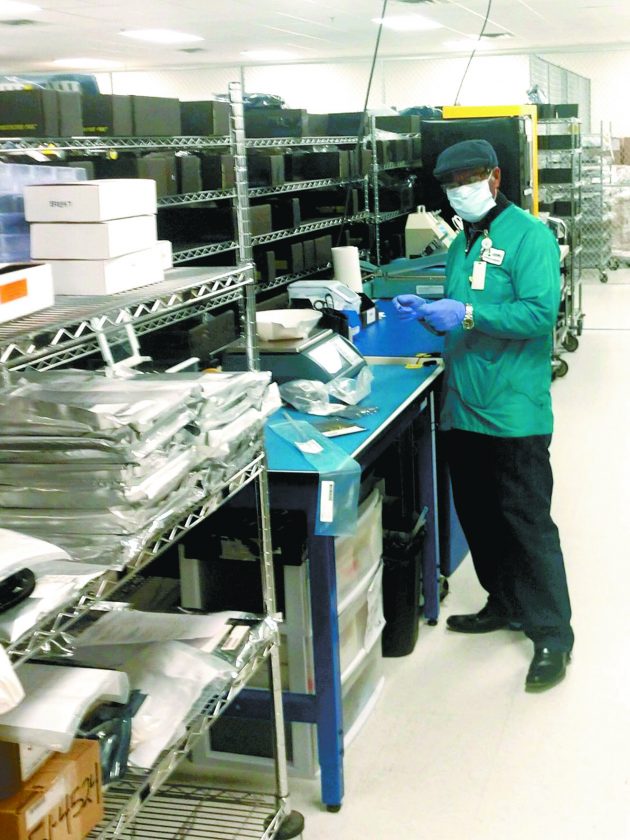Cirtronics remains vital during COVID crisis

A worker at Cirtronics, an employee-owned company in Milford, wears personal protective equipment while completing his daily routine. Courtesy photo
MILFORD – For Cirtronics, an employee-owned, contract manufacturing company located in Milford, few tweaks were needed as the global firm continues to conduct day-to-day operations amidst the COVID-19 crisis.
Medical and health technology and military and robotics are their largest manufacturing segments, followed by aerospace and security. They also build semi-conductors, communications tech and industrial components as well.
Stephanie Gronvall, director of marketing, said that while routines have been adjusted to keep employees safe, Cirtronics’ production endeavors have remained very busy.
“What we are manufacturing, the core of what we do, systems assemblies and boards, that hasn’t changed,” Gronvall said. “The majority of that is because we are a contract manufacturer, so anything with electronics in it or mechanical assembly we can do.”
At this point, the demand from Cirtronics’ customers has remained consistent, if not gone up. Gronvall said they’ve seen an increase in medical devices and military applications as well.
“We need to stay focused on serving the customer,” she said. “Nothing at this time is out of the ordinary. But there have been a lot of conversations with companies who are in need of different products that require our process, and we’re here and ready to manufacture whatever they need.”
As such, Cirtronics is considered an essential business. Gronvall said that is driven by the critical infrastructure of what they do.
The pandemic itself has affected their workforce, but Cirtronics addressed early on the possibility that the coronavirus might be something that would take immense consideration.
“We made a large number of changes early on,” said Jessica Kinsey, career development manager for Cirtronics’ learning center. “Cirtronics established a COVID-19 response team in February. There was immediate response to the news that this was something that we would have to respond to as a corporation.”
Changes made internally included installing hand sanitizer stations and issuing flyers to staff about handwashing, coughing into their elbows and maintaining safe distances between other employees.
“We made some substantial changes in our cafeteria,” Kinsey said. “We physically removed cafeteria seating, so it wasn’t an option for people to sit close to one another. We also held educational meetings with our workforce in terms of how the corporation was responding to and how individuals could help mitigate potential risks.”
Cirtronics also brought in Harvard Pilgrim health reps, including a nurse, to address specific concern and questions that the workforce might have had.
“In terms of responding to the operations, the director of manufacturing and our team leaders looked at the production and shifted staffing resources so that staff like Stephanie and myself who could work from home, were working from home to mitigate risks.”
Additionally, people working first shift, which contained Cirtronics biggest numbers of workers, moved to second shift so the company could ensure safe and proper space between employees.
According to Kinsey, the community outreach program by Cirtronics is driven by the company’s mission of a “duo” philosophy: do onto others.
“Our key constituents are specifically served,” she said. “There are six that we serve, and they are the customer, the corporation, the employee owner, the environment, the supplier and the community. So, we have employee-owner committees that are dedicated to serving the environment, the community and the employee-owner through specific activities.”
Kinsey added that they’ve had to scale back some of their initiatives, including volunteer initiatives tht have been “put on pause.”
“Many of the organizations we work with have also come up with electronic communications to keep people engaged with their mission,” she said. “But we really are being more selective as to how we can engage with our community partners at this time.”
Gronvall said that with reference to the suppliers that Cirtronics does business with, one of the things that has benefited their firm is that in order to serve their customers, they have strong U.S. and local suppliers.
“There are some small business suppliers that work with us,” she said. “But the concern for our customers has been with everything going on, would we be able to continue to build? Because we had reliable partnerships established well before this pandemic, that has helped keep things going.”
“We regularly speak with our supply chain partners and protect our customers by sharing our material demand system. We have a very sophisticated supply chain management and very tight partnerships with our suppliers,” Gronvall added. “We’ve been proactively utilizing those stores and our local partners to be able to serve our customers.”
Per Kinsey, the one caveat through everything has been that the team environment and dialogue between employees has been diminished because of social distancing.
“We’ve done some unique things on that side,” she said. “We just developed a really cool YouTube video with everyone saying hello to everybody. Waving, talking about staying safe, and we created these great team shirts for everyone that were sent to their homes. We’re just trying to keep some of that alive – that’s the hardest part.”
EDITOR’S NOTE: This content is being provided for free as a public service to our community during the coronavirus outbreak. Please support local journalism by subscribing to The Telegraph at https://home.nashuatelegraph.com/clickshare/checkDelivery.do;jsessionid=40C089D96583CD7318C1C1D9317B6162.



